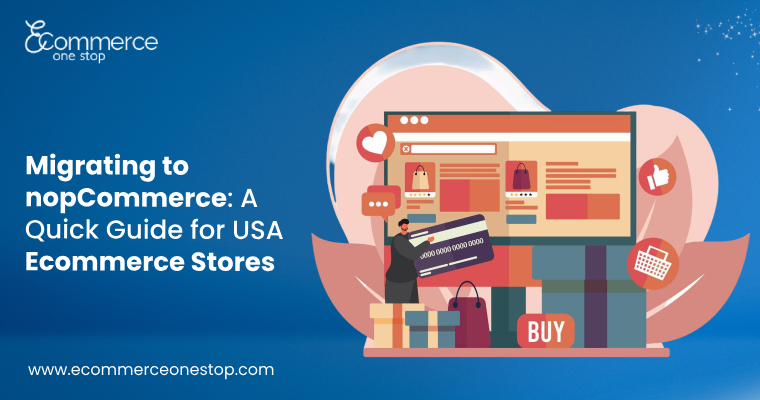In Q1 2025, USA ecommerce sales jumped 5.6% from the same period last year (
U.S. Census Bureau, 2025). Migrating to nopCommerce gets your store ready for this growth by moving data and features to an open-source platform. This blog walks you through the process step by step.
If your USA store needs a fresh start,
nopCommerce website development offers tools for better control and lower costs. Many owners
hire a nopCommerce developer early to handle tricky parts.
Get Your Project Started
Book a free consultation with our Ecommerce experts.
Connect Now

What is nopCommerce?
nopCommerce is an open-source platform for building online stores. It runs on ASP.NET and works with databases like SQL Server. Stores get access to themes, plugins, and community help. For USA businesses, it supports multiple currencies and tax rules by state. It fits small shops or bigger ones with thousands of products. No monthly fees make it stand out.
Why Migrate to nopCommerce in 2025?
Global eCommerce sales are set to reach $6.8 trillion by 2028 (
Forrester, 2024). In the USA, Amazon holds 37.6% of the market (
Statista), making it harder for smaller stores to stand out. Switching to a platform like nopCommerce can help bridge that gap.
By the end of 2025, USA shoppers are expected to use AR when buying online. nopCommerce supports such features through plugins, so there’s no need for separate platforms.
With eCommerce growing each year, open-source options help keep expenses in check while sales grow. Migrating also addresses common issues with older systems such as outdated security, slow site speed, or poor mobile performance.
For USA-based stores, nopCommerce supports popular payment methods like Stripe and benefits from regular community updates, keeping the platform current and ready for evolving customer needs.
How Does the Migration Process Work?
Migrating to nopCommerce involves a series of planned steps to keep your data and store running smoothly.
1. Plan and Review
Start by assessing your current store. List your products, customer records, and order history. Identify any special features or integrations you’ll need in the new store.
2. Back Up Your Data
Save a complete copy of your store’s files and databases before making any changes. Storing backups in the cloud gives you quick access if needed.
3. Set Up nopCommerce
Choose a hosting service and install nopCommerce. Create the required database and prepare the basic store structure. For USA-based stores, hosting on local servers can improve loading speed.
4. Transfer Your Data
Use migration tools like Cart2Cart or LitExtension to move your products, orders, and customer details.
- Connect your old and new stores.
- Select the data you want to move.
- Run a test migration to check results before completing the full transfer.
- Preserve your existing SEO URLs to keep your search rankings stable.
5. Add Your Store’s Design and Features
Install themes and plugins that match your preferred design and functionality. For USA stores, set up payment gateways and sales tax configurations according to state laws.
6. Test Everything
Check every part of your store like product pages, checkout process, payment gateways, and site speed. Conduct test purchases to confirm smooth transactions.
7. Launch Your Store
When all tests are complete, update your domain settings (DNS) to point to the new store. Keep an eye on performance and customer feedback during the first few days.
A professional
nopCommerce development company can handle each stage for you, helping avoid common migration issues and saving you time.
What Challenges Come Up During Migration?
Supporting 90% of consumers who shop on multiple platforms, nopCommerce syncs websites, apps, social media, and stores for a unified experience (
Forbes). During a migration, common challenges that may arise are:
- Data mismatches: Old database formats may not align with the new system, requiring cleanup or conversion.
- Downtime concerns: Migration can temporarily affect site availability, so it’s better to plan the move during low-traffic hours.
- Custom code updates: Features built on the old platform may need to be rewritten or adapted. A skilled nopCommerce developer can handle this.
- SEO impact: Moving to a new setup can affect search rankings. Setting up proper redirects helps maintain visibility.
- Expert guidance: Working with an experienced nopCommerce development company can reduce migration risks and speed up the process.
Conclusion
Switching to nopCommerce can prepare your USA store for growth in 2025 by giving you access to free features, active community support, and straightforward updates. By following the migration steps carefully, you can make your store easier to manage and improve the overall shopping experience for your customers.
If you’re planning to move, our
nopCommerce development team can guide you through the process and set up everything you need for a smooth transition.
FAQs
1. How much does nopCommerce cost for a USA store?
nopCommerce is free to download and use, with no licensing fees. You pay only for hosting and any premium plugins.
2. Which is better for startups: nopCommerce or WooCommerce?
nopCommerce suits startups needing strong inventory tools, while
WooCommerce works for simpler
WordPress sites. Pick based on your tech stack.
3. Why choose nopCommerce over Magento for big stores?
nopCommerce offers easier setup and lower hosting costs than
Magento, which can get complex for larger catalogs.
4. How long does a typical migration take?
Migrations last from hours for small stores to weeks for big ones, depending on data size and custom work.
5. Can nopCommerce handle international sales from the USA?
Yes, it supports multiple languages and currencies, making cross-border sales straightforward.



